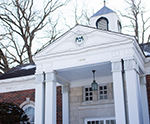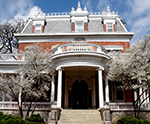Check out these unique destinations that reflect the genuine character of our region.
Sunderlage Farmhouse
1775 Vista Lane, Hoffman Estates, (847) 781-2606, s-t-h-s.org
Sunderlage Farmhouse is more than the oldest standing residence in Schaumburg Township – it’s a building that has ties to the area’s first European settlers and has served as an important meeting place.
Built in 1853 by Johann Sunderlage, the farm was the second home built here by German settlers, who were first introduced by Sunderlage.
The farm remained in the family until the 1940s, after which it was bought and sold many times. In 1977, Peter Volid, president of King Corn Stamp Co., donated the farm to the Village of Hoffman Estates.
Renovations to the structure soon began and continued into the late 1980s. The original plan was to open the first floor to the public and have the second floor become a caretaker’s residence. Instead, the building was used as a public meeting place.
The property is now surrounded by condominiums, and three homeowners associations meet there. The space is also frequently used for weddings, baby and bridal showers, and family holidays. There are special events for children throughout the year.
The Hoffman Estates Historic Sites Commission maintains the home and hosts several functions each year. On July 26, the 8th Cavalry Volunteers holds a Civil War re-enactment on the grounds.
Improvements to the farmstead continue, including increased wheelchair accessibility. Accordingly, the farm is not on the National Register of Historic Places, although an adjacent smokehouse is listed.
Harmony School
U.S. 20 & Harmony Road, Harmony
There was a time when Harmony School looked like a time capsule. Harmony’s small country school was first built in 1859, at what’s now the intersection of U.S. 20 and Harmony Road. At first, it educated students seven months of the year, according to the agricultural calendar.
By the early 1900s, Harmony School had adopted a nine-month calendar, and began teaching students ages 5 to 15.
In 1931, the original structure was replaced by a more modern building, and area farmers collaborated to create what was considered a “centerpiece” of Harmony. Blackboards and woodwork from the original school were installed and remain today.
The school closed in 1950, and eventually became The Harmony Real Estate Co., whose owner maintained the building to the point of leaving chalk on the chalkboards. Following his death, the building quickly fell into foreclosure.
For a short time, there was discussion about moving the school, but it was instead purchased by the owner of the property next door.
Most recently, the Illinois Department of Transportation proposed creating a roundabout at this intersection, which would have required moving or razing the schoolhouse. Curent plans for the roundabout place it northeast of the school.
The building isn’t currently open to the public, but in October 2013 it was designated as a Local Historic Landmark.
Lustron Homes
Various locations in Algonquin, Harvard, Marengo, McHenry & Woodstock, mchsonline.org
Following World War II, the promise of a home that defied weather and required limited maintenance sounded pretty good to many young families. A company with Chicago ties promised to deliver just that.
Lustron Homes were prefabricated, enameled steel houses that were originally built in three styles and four colors: Surf Blue, Dove Gray, Maize Yellow and Desert Tan.
These unique homes are most easily identified through their square, baked-on enameled paneling. The interiors featured metal “easy-to-clean walls,” pocket doors and, most frequently, a two-bedroom floor plan.
With so many GIs returning home from the war, these prefabricated structures were a quick and easy way to overcome the housing shortage.
Lustron Homes, started in 1947, was led by Chicago’s Carl Strandlund, who had previously constructed prefabricated gas stations. The homes were designed by Morris Beckman of Chicago’s Beckman & Blass.
Within a few years, Lustron homes could be found in 36 states. It’s estimated that over the course of two years, more than 45,000 Lustron homes were built.
Although the Lustron Corporation declared bankruptcy in 1950, about 2,000 of its homes are still in existence today, many with modifications.
Seven Lustron homes can still be seen in McHenry County. The home pictured, in Desert Tan, is at 605 W. Judd St., Woodstock. Other addresses: 2423 Mogra Dr., McHenry; 1603 N. River Road, Algonquin; 200 S. Johnston St. & 1005 N. Hart Blvd., Harvard; and 333 Elm St. & 741 E. Prairie St., Marengo.
Although the exteriors of some have been modified from their original state, they all have the distinctive appearance of a Lustron Home.





















































